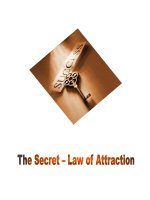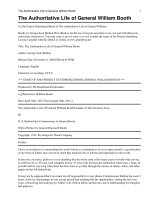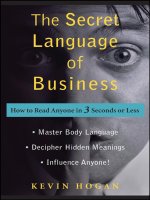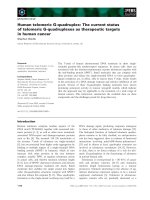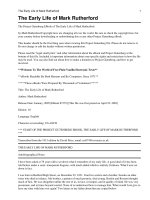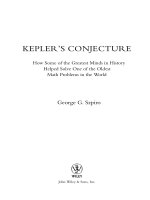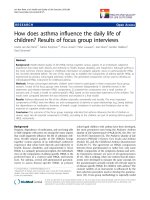- Trang chủ >>
- Khoa Học Tự Nhiên >>
- Vật lý
george g. szpiro - the secret life of numbers 50 easy pieces on how mathematicians work and think
Bạn đang xem bản rút gọn của tài liệu. Xem và tải ngay bản đầy đủ của tài liệu tại đây (2.87 MB, 223 trang )
Visit the Joseph Henry Press online to see more top quality, general interest
science books:
• Read books online, free
• Explore our innovative research tools
• Sign up to be notified when new books are published
• Purchase printed books
• Purchase PDFs
The Joseph Henry Press, an imprint of the National Academies Press, was created with the goal of
publishing well-crafted, authoritative books on science, technology, and health for the science-interested
general public. All Joseph Henry Press books go through scientific review before being published. The
opinions expressed in this book are solely that of the author(s) and do not necessarily reflect the views of
the National Academies.
Thank you for downloading this PDF. If you have comments, questions or
just want more information about the books published by the National
Academies Press and the Joseph Henry Press, you may contact our
customer service department toll-free at 888-624-8373, visit us online, or
send an email to
This book plus many more are available at .
Copyright © All rights reserved.
Distribution, posting, or copying is strictly prohibited without written permission of the National
Academies Press. Request reprint permission for this book.
ISBN: 0-309-65958-2, 224 pages, 5 1/2 x 8 1/2, (2006)
This PDF is available from the Joseph Henry Press at:
/> />We ship printed books within 1 business day; personal PDFs are available immediately.
The Secret Life of Numbers: 50 Easy Pieces on How
Mathematicians Work and Think
George G. Szpiro
George G. Szpiro
Joseph Henry Press
Washington, D.C.
Joseph Henry Press • 500 Fifth Street, NW • Washington, DC 20001
The Joseph Henry Press, an imprint of the National Academies Press,
was created with the goal of making books on science, technology,
and health more widely available to professionals and the public.
Joseph Henry was one of the founders of the National Academy of
Sciences and a leader in early American science.
Any opinions, findings, conclusions, or recommendations expressed
in this volume are those of the author and do not necessarily reflect
the views of the National Academy of Sciences or its affiliated insti-
tutions.
Library of Congress Cataloging-in-Publication Data
Szpiro, George G.
The secret life of numbers : 50 easy pieces on how mathematicians
work and think / George G. Szpiro.
p. cm.
Includes bibliographical references and index.
ISBN 0-309-09658-8 (cloth : alk. paper) 1. Mathematics—History.
I. Title.
QA21.S995 2006
510—dc22
2005030601
Cover design by Michele de la Menardiere
Copyright 2006 by George G. Szpiro. All rights reserved.
Translated by Eva Burke, London
Printed in the United States of America
Dedicated to my parents
Marta and Benno Szpiro
my wife
Fortunée
and my children
Sarit, Noam, and Noga
Contents
Preface xi
PART I
HISTORICAL TIDBITS
1 Lopping Leap Years 3
2 Is the World Coming to an End Soon? 6
3 Cozy Zurich 8
4 Daniel Bernoulli and His Difficult Family 11
PART II
UNSOLVED CONJECTURES
5 The Mathematicians’ Million Dollar Baby 17
6A Puzzle by Any Other Name 20
7 Twins, Cousins, and Sexy Primes 24
8 Hilbert’s Elusive Problem Number 16 27
PART III
SOLVED PROBLEMS
9 The Tile Layer’s Efficiency Problem 33
10 The Catalanian Rabbi’s Problem 37
11 Even Infinite Series End Sometimes 40
12 Proving the Proof 43
13 Has Poincaré’s Conjecture Finally Been Solved? 48
PART IV
PERSONALITIES
14 Late Tribute to a Tragic Hero 55
15 The Unpaid Professor 59
16 Genius from a Different Planet 61
17 The Resurrection of Geometry 66
18 God’s Gift to Science? 69
vii
viii CONTENTS
19 Vice-President of Imagineering 75
20 The Demoted Pensioner 80
21 A Grand Master Becomes Permanent Visiting
Professor 85
PART V
CONCRETE AND ABSTRACT MATTERS
22 Knots and “Unknots” 93
23 Knots and Tangles with Real Ropes 97
24 Small Mistakes May Have Large Consequences 102
25 Ignorant Gamblers 106
26 Tetris Is Hard 109
27 Groups, Monster Groups, and Baby Monsters 112
28 Fermat’s Incorrect Conjecture 116
29 The Crash of Catastrophe Theory 119
30 Deceptive Simplicity 122
31 The Beauty of Dissymmetry 125
32 Random and Not So Random 128
33 How Can One Be Sure It’s Prime? 132
PART VI
INTERDISCIPLINARY POTPOURRI
34 A Mathematician Judges the Judges (Law) 137
35 Elections Aren’t Decided by the Voters Alone
(Political Science) 140
36 A Dollar Isn’t Always Worth a Dollar
(Insurance) 146
37 Compressing the Divine Comedy (Linguistics) 149
38 Nature’s Fundamental Formula (Botany) 155
39 Stacking Words Like Oranges and Tomatoes
(Computer Science) 158
40 The Fractal Dimension of Israel’s Security
Barrier (Geography) 161
41 Calculated in Cold Ice (Physics) 164
42 Built on Sand (Physics) 167
43 Buzzing Around Corners (Biology) 170
CONTENTS ix
44 Inexperienced Traders Make the Market Efficient
(Economics) 172
45 The Waggle Dance of Internet Servers (Computer
Science, Biology) 175
46 Turbulent Liquids and Stock Markets (Finance,
Economics) 178
47 Encrypting Messages with Candles and Hot Plates
(Cryptography) 180
48 Fighting for Survival (Evolutionary Theory,
Finance) 184
49 Insults Stink (Neurosciences, Economics) 187
50 Bible Codes: The Not So Final Report
(Theology) 190
References 195
Index 199
xi
Preface
Whenever a socialite shows off his flair at a cocktail party
by reciting a stanza from an obscure poem, he is consid-
ered well-read and full of wit. Not much ado can be made
with the recitation of a mathematical formula, however.
At most, one may expect a few pitying glances and the
title “party’s most nerdy guest.” To the concurring nods
of the cocktail crowd, most bystanders will admit that
they are no good at math, never have been, and never
will be.
Actually, this is quite astonishing. Imagine your law-
yer telling you that he is no good at spelling, your dentist
proudly proclaiming that she speaks no foreign language,
and your financial advisor admitting with glee that he
always mixes up Voltaire and Molière. With ample rea-
son one would consider such people as ignorant. Not so
with mathematics. Shortcomings in this intellectual dis-
cipline are met with understanding by everyone.
I have set myself the task of trying to remedy this
state of affairs somewhat. The present book contains ar-
ticles that I wrote on mathematics during the past three
years for the Swiss daily newspaper Neue Zürcher Zeitung
and its Sunday edition NZZ am Sonntag. It was, and is,
my wish to give readers an understanding not only of the
importance but also of the beauty and elegance of the
subject. Anecdotes and biographical details of the oftentimes
quirky actors are not neglected, but, whenever possible, I
give an idea of the theories and proofs. The complexity of
mathematics should neither be hidden nor overrated.
Neither this book nor, indeed, my career as a math-
ematics journalist evolved in a linear fashion. After stud-
ies of mathematics and physics at the Swiss Federal Insti-
tute of Technology in Zurich and a few career changes, I
became the Jerusalem correspondent for the Neue Zürcher
Zeitung. My job was to report about the goings-on in the
Middle East. But my initial love for mathematics never
waned, and when a conference about symmetry was to be
held in Haifa, I convinced my editor to send me to this
city in northern Israel in order to cover the gathering. It
turned out to be one of the best assignments I ever did
for the paper. (It was nearly as good as the cruise on a
luxury liner down the Danube to Budapest, but that is
another story.) From then on I wrote, on and off, about
mathematical themes.
In March 2002 I had the opportunity to make use of
my mathematical interests in a more regular fashion. The
NZZ am Sonntag launched the monthly feature “George
Szpiro’s little multiplication table.” I soon found out the
hard way that the reception by the readers was better
than expected: The incorrect birth date of a mathemati-
cian in one of the early columns led to nearly two dozen
readers’ letters ranging in tone from the ironic to the
angry. A year later I received a special honor when the
Swiss Academy of Sciences awarded the column its Me-
dia Prize for 2003. In December 2005, at a ceremony at
the Royal Society in London, I was named a finalist for
the European Commissionís Descartes Prize for Science
Communication.
I would like to thank my editors in Zurich—Kathrin
Meier-Rust, Andreas Hirstein, Christian Speicher, and Stefan
Betschon—for their patient and knowledgeable editorial
work, my sister Eva Burke in London for diligently trans-
lating the articles, and Jeffrey Robbins of the Joseph Henry
Press in Washington, D.C,. for turning the manuscript
into what I hope has become an enjoyable book on a
subject commonly thought of as dry as a bone.
George G. Szpiro
Jerusalem, Spring 2006
xii PREFACE
I
Historical Tidbits
I
3
1
Lopping Leap Years
In early 2004 a phenomenon occurred that happens only
about four times in the course of a century: There were
five Sundays during the month of February. Such an event
can only be witnessed every seventh leap year, that is,
once in 28 years. The last time this happened was in
1976; the next time will be in 2032.
A lot is odd about leap years. Astronomers have ob-
served that the time between two spring equinoxes is 365
days, 5 hours, 48 minutes, and 46 seconds, or 365.242199
days, which in turn equals nearly, but not exactly, 365.25
days. As an approximation this is good enough, though,
and in the middle of the 1st century Julius Caesar intro-
duced the calendar that would henceforth carry his name.
Every three years, with 365 days each, would be followed
by a leap year, which would include an additional day.
For the following millennium and a half, the years thus
had an average length of 365.25 days.
But toward the end of the 16th century the gentlemen
of the Catholic Church were no longer prepared to put up
with an annual error of 11 minutes, 14 seconds. Consult-
ants to the Vatican had calculated that within 1,000 years
the annual mistake would accumulate to a difference of
eight entire days. Thus, in a mere 12,000 years, they pointed
out, Christmas would fall in the autumn season and Eas-
ter would have to be celebrated in January. Since the
Church plans for the long term, such inaccuracies are
unacceptable.
Pope Gregory XIII (1502–1585) had a long think about
all this and eventually arrived at the conclusion that the
Julian year—the year according to Julius Caesar—was simply
too long. To compensate for the inaccuracy, the Pope de-
cided to adjust the calendar by leaping over some of the
leap years: for each 25th leap year the leap day, originally
4 THE SECRET LIFE OF NUMBERS
added by Caesar, would be canceled. Thus, the month of
February of the last year of each century—that is, each
year that is divisible by 100—would only have 28 days,
even though it should have been a leap year. The years
whose leap days were being lopped off could thus be re-
named as “lop leap years.” Every century would thus have
75 regular years with 365 days, 24 leap years with 366
days, and a lop leap year with, again, 365 days. On aver-
age, a year would then have a length of 365.24 days.
This, however, falls short again—albeit to a small ex-
tent, but short nevertheless. A further adaptation was called
for. The Pope and his advisers put their thinking caps on
yet again and hit on another idea: Reinsert the leap day
into every fourth lop leap year. Thus the loop would be
closed, so to speak, and those years that are divisible by
400 were to be “loop lop leap years.” Since the year 1600
was just around the corner, it was declared the first “loop
lop leap year.” The next one would be the year 2000.
Thus the average length of a year was now precisely
365.2425 days (three centuries with an average length of
365.24 days; one century with an average length of 365.25
days). Well, wouldn’t you know it? This is just a wee bit
too long. But by then Pope Gregory XIII had had enough.
There would be no further corrections or adjustments.
Not even the Church, known for its long-term planning,
was prepared to go the extra . . . well, millimeter, consid-
ering the order of magnitude here discussed. The discrep-
ancy of 26 seconds per year amounts to no more than a
day every 3,322 years.
Future inaccuracies of the calendar had thus been taken
care of, but what about the inaccuracies that had accu-
mulated during the millennium and a half since Julius
Caesar introduced his calendar? Pope Gregory’s ingenuity
solved the problem with one ingenious stroke: In 1582 he
struck 10 entire days from the calendar. This drastic step
had an additional benefit to the pontiff. It was an oppor-
tunity to show the world and its rulers who the true
master was. So what happened was that Thursday, Octo-
ber 4, 1582, was followed in most Catholic countries by
Friday, October 15.
HISTORICAL TIDBITS 5
But the non-Catholic countries had absolutely no in-
tention of obeying the Pope’s diktat. In England and its
colonies (including America), the correction took place as
late as 1752, at which point 11 days had to be struck
from the calendar. The Russians stuck to their calendar
until the Revolution but were then forced to cross out 13
days. The abstruse result was that the October Revolu-
tion in fact took place in November 1917.
Not all is well, however, and no one yet knows how it
will all end. Even though everything seemed to run rather
smoothly since Pope Gregory’s adjustments, 400 years later
all is threatening to fall apart again. Science has made
huge progress, and atomic clocks can nowadays measure
time with a precision of 10
–14
.
1
This corresponds to an
error of not more than one second every 3 million years.
With such precise measurements, an annual surplus of 26
seconds becomes once again unbearable. So, what this
writer wishes to propose is one further adjustment: De-
lete the reinserted additional leap day every eighth loop
lop leap year. Hence, every 3,200 years, the month of
February would again comprise only 28 days. This would
be the final lap in the rounds of adjustments; hence, that
particular year would be called the “lap loop lop leap
year.” The average year would last for 365.242188 days.
Based on painstaking calculations, it turns out that the
first lap loop lop leap year would be upon us in AD 4400.
So we still have some time to think this whole thing
over. The average year would still be one second short,
but it would take 86,400 years for this error to accumu-
late to a full day. This is an imprecision with which even
the loopiest mathematicians and church people could lope
. . . I mean cope.
1
This is a scientific way of writing 0.00000000000001.
2
Is the World Coming to
an End Soon?
Isaac Newton was, as we all know, the most outstanding
scientist and mathematician of the 17th and 18th centu-
ries. He is considered the father of physics and the founder
of the law of gravity. But was he really the rational thinker
as we would have it today? Far from it. As it turns out,
Newton was also a religious fundamentalist who devoted
himself to intense Bible study and who wrote over a mil-
lion words on biblical subjects.
Newton’s aim was to unravel nothing less than God’s
secret messages. According to the great scientist, they
were hidden in the Holy Scriptures. Above all Newton
was intent on finding out when the world would come to
an end. Then, he believed, Christ would return and set
up a 1,000-year Kingdom of God on earth and he—Isaac
Newton, that is—would rule the world as one among the
saints. For half a century, Newton covered thousands of
pages with religious musings and calculations.
Three hundred years later, toward the end of 2002,
the Canadian historian of science Stephen Snobelen of
King’s College in Halifax found a significant document
among a convoluted mass of manuscripts that had been
left in the home of the Duke of Portsmouth for over 200
years. They had been kept from public scrutiny until 1936,
when they were sold at an auction at Sotheby’s. The col-
lection was acquired by the Jewish scholar and collector
Abraham Yehuda, an Iraqi professor of Semitic languages
who, upon his death, left them to the State of Israel’s
Jewish National Library. Ever since, they have been gath-
ering dust in the archives at the Hebrew University in
Jerusalem.
When Snobelen assessed the manuscripts, he chanced
upon a piece of paper on which the famous physicist had
6
HISTORICAL TIDBITS 7
calculated the year of the apocalypse: 2060. Newton ar-
rived at this date based on razor-sharp conclusions. From
his readings of the Book of Daniel (Chapter 7, Verse 25)
and the Book of Revelations, the physicist concluded that
the time span of three and a half years signified a critical
time period. Basing a year on 360 days—a simplification
that comes easy to a mathematician—this time span cor-
responds to 1,260 days. By simply replacing days by years,
the illustrious Bible researcher easily concluded that the
world would come to an end 1,260 years after a particular
commencing date.
So now the critical question was, what was the com-
mencing date? Newton had several dates to choose from,
each of which was somehow connected to Catholicism, a
religion he loathed to the core. Richard Westfall, author
of the definitive biography on Newton, pointed out that
Newton had singled out the year 607 as a significant date.
It referred to the year in which Emperor Phokas bestowed
on to Bonifatius III the title of “Pope Over All Chris-
tians.” This edict elevated Rome to “caput omnium
ecclesarum” (head of all churches)—truly a worthy occa-
sion to mark the beginning of the end. Since 607 + 1,260
= 1,867, Newton predicted that the end of the world would
occur in the year 1867. But today we know with absolute
certainty that the world did not come to an end then.
Newton had prepared for such a problem with a fallback
strategy. During his research in Jerusalem, the Canadian
professor also came across the year 800. This is a signifi-
cant date in history since on Christmas day of that year
Pope Leo III crowned Charlemagne at St. Peter’s in Rome.
It was the beginning of the “Holy Roman Empire of the
German Nation.” And 800 plus 1,260 equals 2,060. An-
other half century or so, and the world as we know it will
call it quits. Quod erat demonstrandum.
If one or the other reader has started to feel slightly
queasy after reading the last few lines, let him or her
heave a sigh of relief. Newton had another fallback posi-
tion. According to further calculations of the eminent
physicist, the end of the world could be somewhat de-
layed and take place at the latest in the year 2370.
3
Cozy Zurich
Professors in Zurich are probably not quite aware of how
lucky they are. A visiting professor, invited to give a lec-
ture series at the University of Zurich, can attest to the
fact that the circumstances that prevail in this city can
be described as nothing less than paradisiacal.
As soon as one sets foot in the lecture hall, it seems
that the golden age has dawned. Spanking-clean black-
boards gleam in pleasant anticipation, the appropriate con-
tainer is filled with virginal chalks, a clean sponge above
the water basin (note: with cold and hot water) awaits its
deployment, and a specially designed fastener holds a wind-
shield wiper kind of contraption for drying the black-
board. Next to it a freshly washed and ironed kerchief
dangles from a hook. It is to be used after the blackboard
has been given the workover with sponge and windshield
wiper in order to return to it the luster it deserves. Two
overhead projectors stand ready with separate sets of scru-
pulously aligned, colored, felt-tipped pens next to them.
Surrounded by all this luxury, the lecturer cannot but
recall with melancholy the conditions at his faraway home
university. There one secures sundry materials before each
lecture oneself and picks up some toilet paper on the
way, in order to wipe the blackboard, if not clean, then at
least partially clean when it gets too crowded. If a projec-
tor is required, the lecturer reports to the dean’s office.
With luck, one of the monsters is available and, after
having acknowledged receipt on a special form, one is
permitted to lug the contraption through interminable
corridors while the extension cord keeps wrapping itself
around one’s legs. After the lecture, the monster, which
at this point seems to have gained considerable weight, is
shlepped back to the dean’s office.
In Zurich, if the professor requires a computer with
8
HISTORICAL TIDBITS 9
special software in order to demonstrate the workings of
a simulation in real time, the class need not be resched-
uled to a computer lab. Rather, a friendly “house techni-
cian,” dressed in dapper overalls, rolls a computer—with
the necessary software having been installed the previous
night—into the lecture hall at precisely the right mo-
ment, attaches it to the overhead projector, and hands
the remote control to the lecturer. Mouse and keyboard
wait for their cue.
Seemingly insurmountable obstacles are overcome with
ease in Zurich. One hour before the planned projection of
a video film, it turns out that the tape was recorded in
the National Television Systems Committee (NTSC) sys-
tem, which is not current in Europe. The desperate lec-
turer sprints down to the house technicians office where
one of those gnomes of Zurich patiently explains that,
first of all, there are two versions of the NTSC system;
second, that projectors are of course available for the one
as for the other; and, third, that both machines will be
set up in the lecture hall, just to be on the safe side.
Before the screening of the movie, the house techni-
cian gives the lecturer a crash course in the operation of
the instrument panel that is embedded in the wall next
to the blackboard and which, to the uninitiated, carries
an astounding similarity to the cockpit of a Boeing 747.
All lights, dimmers, and switches for projectors, video
machines, and computers may be controlled from this
strategic command post. If, despite all precautions, some-
thing should not work to the complete satisfaction of all
present, a quick call to the house technicians nerve cen-
ter suffices (telephones are available on every floor, in
every corridor). Within minutes a competent and friendly
gentleman is on the spot to straighten everything out.
Seating arrangements in the lecture halls can be changed
at request, of course. If a sociologist wants to demon-
strate group dynamics, chairs and tables are moved close
together. But in the break before the next lecture, a house
technician swiftly aligns the furniture again, and at the
sound of the bell all chairs stand at attention at their
appropriate places.
10 THE SECRET LIFE OF NUMBERS
It goes without saying that all students are at the ready
at the start of each class. And if a blushing student, mumbling
an apology, does happen to sneak in late, one is again
painfully reminded of the realities at home. There the
latecomers—about a third of the registered auditors in an
average class (another third do not show up at all)—walk
proudly into class at any time, dispense friendly greet-
ings to the left and right before taking their seats, and do
not hesitate to consult today’s newspaper for important
news if the content of the lecture is, in their opinion, too
boring.
4
Daniel Bernoulli and
His Difficult Family
More than two centuries have passed since the death of
one of the most distinguished mathematicians in history:
Daniel Bernoulli (1700–1782). The name Bernoulli calls
for precision since the family from the Swiss town of
Basle produced no fewer than eight outstanding math-
ematicians within three generations. Because the same
given names kept being used by the family over and over
again, a numbering system was adopted to tell fathers,
brothers, sons, and cousins apart. It starts with Jakob I
and his brother Johann I (the third brother, Nikolaus, be-
ing an artist, wasn’t given a number). Then there are, in
the next generation, Nikolaus I and Johann’s three sons—
Nikolaus II, Daniel, and Johann II. Finally, the two sons
of Johann II, called Johann III and Jakob II, followed in
the footsteps of their brilliant ancestors. (Johann’s third
son, Daniel, didn’t get any further than being deputy pro-
fessor at the University of Basle. Hence he wasn’t given a
number, which is why his famous uncle and namesake
didn’t need one either.)
Together with Isaac Newton, Gottfried Wilhelm Leibniz,
Leonhard Euler, and Joseph-Louis Lagrange, the Bernoulli
family dominated mathematics and physics in the 17th
and 18th centuries. The family members were interested
in differential calculus, geometry, mechanics, ballistics,
thermodynamics, hydrodynamics, optics, elasticity, mag-
netism, astronomy, and probability theory. For more than
30 years, the Swiss National Fund has been supporting
work on an edition of the complete works of Jakob I,
Johann I, and Daniel. The complete edition will comprise
24 volumes. Another 15 volumes, including a selection of
their 8,000 letters, is to follow.
Unfortunately, the gentlemen from Basle were as con-
11
12 THE SECRET LIFE OF NUMBERS
ceited and arrogant as they were brilliant and engaged
constantly in rivalry, jealousy, and public rows. Actually,
everything had started so idyllically. Jakob I, who had
acquired his knowledge in the natural sciences as an
autodidact and went on to teach experimental physics at
the University of Basle, secretly introduced his younger
brother to the mysteries of mathematics. This was very
much against the will of their parents, who wanted the
younger brother to embark on a career in commerce after
the elder son had already refused to embark on the cleri-
cal career they had planned for him.
But the harmony between the two highly gifted broth-
ers soon turned into a bitter argument. The conflict be-
gan when Jakob I, annoyed by Johann’s bragging, claimed
in public that the works of his former student were but
copies of his own results. Next Jakob I—who by then
held the chair of mathematics at the University of Basle—
plotted successfully against his brother’s appointment to
his department. So Johann I had to teach at the Univer-
sity of Groningen before finally being offered a chair in
Basle for . . . Ancient Greek. But fate decided otherwise,
and just when Johann set off for his native town, the
news reached him that Jakob had died. Thus the not-too-
grief-stricken brother was given the chair of mathematics
in Basle after all. Jakob’s most important opus, his Ars
Conjectandi (The Art of Conjecture), which appeared af-
ter his death, formed the basis of probability theory.
But don’t believe that Johann I learned anything from
this sad story. In educating his own sons he committed
exactly the same mistakes as his father had done before
him. Claiming that mathematics couldn’t provide a liv-
ing, Johann tried to bully the most gifted of his three
sons, Daniel, into a career in commerce. When this at-
tempt proved unsuccessful, he allowed him to study medi-
cine—all this in order to prevent his son from becoming
a competitor. But the sons followed the example of their
elders, and Daniel, while studying medicine, took lessons
in mathematics from his older brother, Nikolaus II. In
1720 he traveled to Venice to work as a physician. How-
ever, his heart belonged to physics and mathematics, and
